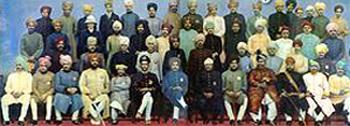|
 While
successive dynasties of kings and kingdoms came and went the institution
of Hindu kingship itself remained constant, providing an autocratic, paternalistic
but essentially benevolent authority under which many varieties of Indian
culture flourished throughout the subcontinent. While
successive dynasties of kings and kingdoms came and went the institution
of Hindu kingship itself remained constant, providing an autocratic, paternalistic
but essentially benevolent authority under which many varieties of Indian
culture flourished throughout the subcontinent.
The India Princes were the diamonds, emeralds,
rubies and pearls that invested the imperial crowns of both the Mughals
and the British with glitter and sparkle. Proud guardians of an ancient
inheritance steeped in history, they gave India splendour and romance
on a scale that was unrivalled in the twentieth century and which will
never reoccur.
The word Raja, with its original Sanskrit meaning of both
'one who rules' and 'one whose duty is to please', was taken very seriously
by the rulers.
Many of Kings represented the finest qualities
of rulership and manhood-their impartiality, sense of fair play, even-handed
justice, truthfulness and high morals were exemplary. They were great
patrons of arts, music and learning. Many were fine horsemen, sportsmen
and lovers of forests. Some were deeply religious and god-fearing and
the people adored and worshiped them.
In the years following the abolition of princely rule, several members
of the order have continued to play a prominent role in various fields
of enterprise. A few, like Rajmata Vijayaraje Scindia of Gwalior and her
son, Madhavrao, are still actively involved in politics. Some, like the
late Maharaja of Baroda set up and ran successful industries, while others
like Divyabhanusinh of Mansa and Pushpendra Sinh of Lunawada, distinguished
themselves as managers in the corporate world.
 Many
former Princes felt committed to reviving the arts and crafts formerly
patronised in their states. The Rajmata of Jaipur revitalised the renowned
blue pottery of Jaipur whilst the late Raja of Sawantwadi converted the
Durbar Hall of his palace into a workshop to revive the dying art of lacquerware
furniture and traditional ganjifa playing cards for which his state was
famous. Richard and Sally Holkar set up a weavers' co-operative in the
palace in Maheshwar to breathe new life into the town's dormant textile
industry, whereas the Nawabzada of Palanpur has run a successful arts
and crafts boutique in Bombay for several years. The Maharawal of Pratapgarh
motivates members of the one family that has had the monopoly in crafting
exquisite theva jewelry, which employs the technique of intricately patterned
gold filigree on coloured glass. Bapa Dhrangadhara is occupied in restoring
rate, antique shawls while his brother. Sidhharaj Sinhji, has established
a crafts center in the palace at Dhrangadhara to revive the art of silver
and stone furniture. Schools of classical music known as gharanas, such
as those established by the royal courts of Jaipur, Gwalior, Patiala,
Baroda, Kapurthala, Rampur, Maihar and Indore, still flourish. Many
former Princes felt committed to reviving the arts and crafts formerly
patronised in their states. The Rajmata of Jaipur revitalised the renowned
blue pottery of Jaipur whilst the late Raja of Sawantwadi converted the
Durbar Hall of his palace into a workshop to revive the dying art of lacquerware
furniture and traditional ganjifa playing cards for which his state was
famous. Richard and Sally Holkar set up a weavers' co-operative in the
palace in Maheshwar to breathe new life into the town's dormant textile
industry, whereas the Nawabzada of Palanpur has run a successful arts
and crafts boutique in Bombay for several years. The Maharawal of Pratapgarh
motivates members of the one family that has had the monopoly in crafting
exquisite theva jewelry, which employs the technique of intricately patterned
gold filigree on coloured glass. Bapa Dhrangadhara is occupied in restoring
rate, antique shawls while his brother. Sidhharaj Sinhji, has established
a crafts center in the palace at Dhrangadhara to revive the art of silver
and stone furniture. Schools of classical music known as gharanas, such
as those established by the royal courts of Jaipur, Gwalior, Patiala,
Baroda, Kapurthala, Rampur, Maihar and Indore, still flourish.
Other achievements include distinguished careers in the Civil and Foreign
Services and in the field of sports-particularly cricket, riding, polo
and trap-shooting. Former royal hunting grounds have become national sanctuaries
and parks; these include Bharatpur, Siriska, Ranthambore, Shivpuri, Gir,
Periyar, Rangathittoo, Bandipur, Dachigam and Jaldapara. Royal menageries
and aviaries were set up as zoological parks as in Hyderabad, Baroda,
Junagadh, Gwalior, Mysore, Jaipur, Kotah, Jodhpur, Bikaner and Uadipur.
Many palaces are crumbling today but others like those in Suket, Bikaner,
Rampur, Indore, Jodhpur, Jaipur, Udaipur and Patiala have become repositories
of culture in the form of museums and libraries. Some palaces now function
as Government offices, including those at Indore, Patiala, Palanpur of
Pratapgarh. A large number, like those in Udaipur, Jaipur, Jodhpur, Mysore,
Bikaner, Gwalior, Benares, Kotah, Bhavnagar, Wankaner and Jaisalmer, have
been converted into popular palaces hotels and guest houses.
|

